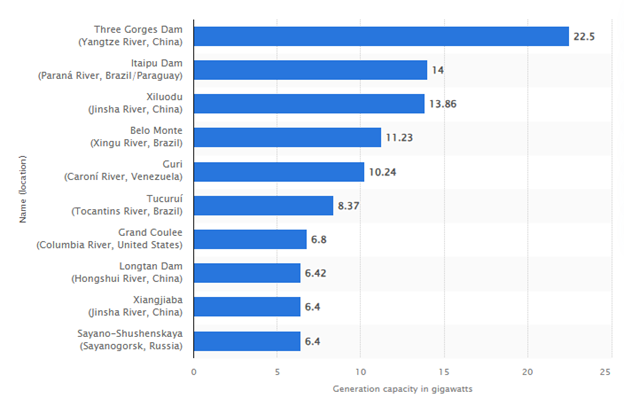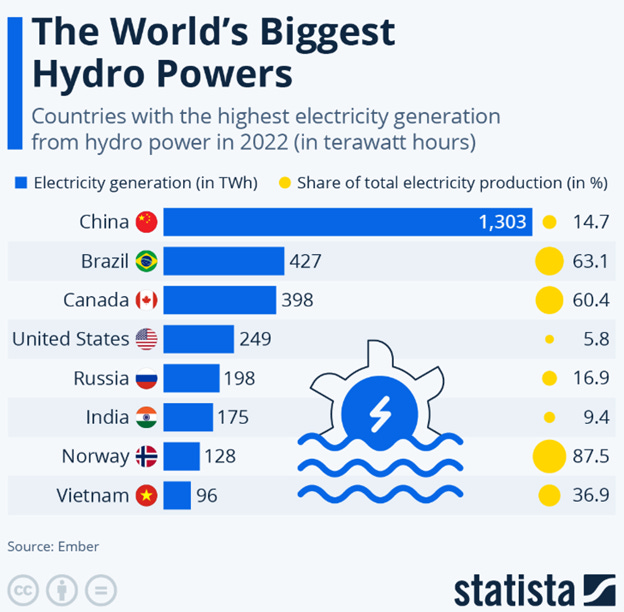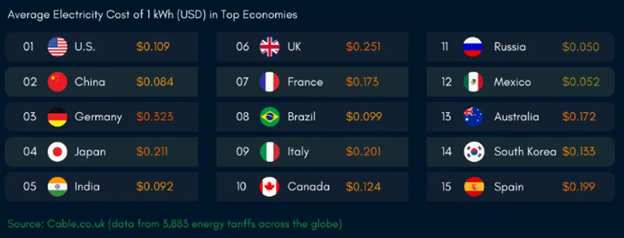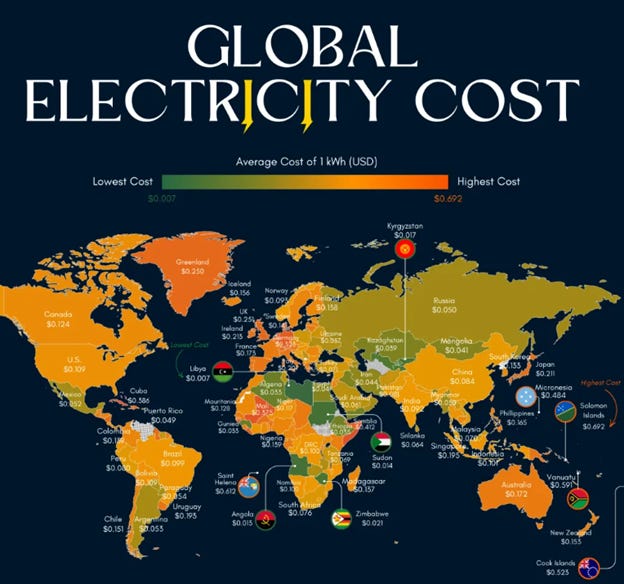China's Tibet Megadam project: 10 years, $170 billion for another Great Britain
Bullets:
Engineers have begun work on the world's largest hydroelectric project, in China's Xizang.
While the topography of the region is ideal for large-scale hydro, they face enormous challenges. The area is remote, the canyon walls are steep and narrow, and it sits in an active earthquake zone.
The project will take a decade to bring online, and will cost at least $170 billion to complete.
But in the context of comparable new power projects globally, $170B is a relative bargain. When complete, the new dam will generate the equivalent of one Great Britain's worth of electric power, every year, and further push down China's already low electricity costs for households and industries.
Report:
Good morning.
When news stories come out about China, we need to do a better job of going deeper, another two or three levels down, to understand the significance of what’s happening here. These features are of China’s giant new hydroelectric project in Tibet. They are well-written and interesting, and hit most of the important aspects of the story. But they all manage to miss the biggest one of all.
The project is in Tibet, and the electricity from the project will used there, in Xizang, and transmitted to other parts of the country. The features here in BBC and Al Jazeera dive in to some of the environmental and ecological concerns. And India, which is downstream of this project, is worried if all the water they’re used to getting will still be coming.
When it’s completed, it will be by far the biggest hydroelectric power project in the world, much larger than the Three Gorges Dam. And Three Gorges is already much larger than any other dam anywhere else; it produces 50% more electricity than the world’s second largest dam. China has four of the top nine spots for the biggest hydro projects in the world, and their new dam will be three times larger than Three Gorges when it comes online:
China produces three times more hydro power than Brazil, which is in the number two spot. Last year, over half of the new hydro power capacity globally that came online was here—in China.
The Yarlung Tsangpo is the longest river in Tibet, and the topography of the place is ideal for hydropower projects, if the Chinese can overcome the enormous engineering challenges involved. The canyons are steep and narrow, which means a high risk of landslides, and the entire area is an active earthquake zone. Naturally that means the project will be very expensive--$127 billion according to this estimate. Al Jazeera says that the number is even higher—estimated costs of $167 billion.
Reuters and SCMP have quoted estimated costs of at least $170 billion. When completed, it will produce 300 billion kilowatt hours of electricity per year, which is what Great Britain consumed last year.
And when we learn that—right there—we realize that $170 billion is not a lot of money—at all. It’s cheap. China is going to add another Great Britain’s worth of electric power generation, for $170 billion.
The population of Great Britain is 70 million people, and is a G7 country that uses a lot of electricity. The UK is trying to keep up with their surging power demand, and is building a major nuclear reactor plant that will hopefully meet 7% of their electricity needs when finished. So far it is expected to cost $59 billion, but nobody knows for sure because the costs keep rising, and the completion date keeps getting pushed back. But let’s pretend that there is no more inflation or labor shortages or supply chain problems in England between now and 2030—and they’re all done for $60 billion dollars, to meet one-fourteenth of the country’s electricity demand. China is spending under three times that--$170 billion---but will produce enough electricity to meet all of the demand. That’s the story.
New power projects in the United States take even longer and cost even more. The most recent nuclear project there just came online, $17 billion over budget and seven years late. Georgia Power spent more than $30 billion to meet SOME of the power needs for 2.7 million of their customers.
We’re comparing apples to oranges, the cost of a new nuclear power plant in the UK compared to one in the US compared to a new hydro power project in Xizang. But a consumer is indifferent as to the source. He needs electricity at a low price. Families and small businesses need reliable, affordable energy. But if you run a factory, affordable electricity is a competitive advantage. If your energy costs are a third what your competitors pay for power in Great Britain, or in Georgia, your total manufacturing costs are lower. You will pass those lower costs on to your customers across the world, and take market share.
China already produces some of the lowest-cost electricity in the world. They already produce more electricity than the United States and the European Union combined. And Chinese engineers are going to spend the next ten years putting spillways into some canyons out in West China, and when they turn the thing on, they will add a Great Britain to the China’s power supply.
Resources and links:
What's the Average Cost of 1 kWh Electricity around the World
https://www.voronoiapp.com/energy/Whats-the-Average-Cost-of-1-kWh-Electricity-around-the-World--3398
Statista, Largest hydroelectric dams worldwide as of 2021, based on power generation capacity
Statista, The World’s Biggest Hydro Powers
https://www.statista.com/chart/32027/countries-with-the-highest-electricity-generation-from-hydro-power/
AP, Georgia nuclear rebirth arrives 7 years late, $17B over cost
Charted: China’s Energy Needs Keep on Rising
https://www.visualcapitalist.com/charted-chinas-energy-needs-keep-on-rising/
AP, UK’s flagship nuclear plant could cost up to $59 billion, developer says
https://apnews.com/article/uk-nuclear-plant-hinkley-point-costs-67adc627f0acf130d3ea6c2423e98c4e
China starts construction of world’s biggest hydropower dam in Tibet
https://www.aljazeera.com/news/2025/7/22/china-starts-construction-of-worlds-biggest-hydropower-dam-in-tibet
Reuters, China embarks on world's largest hydropower dam, capital markets cheer
https://www.reuters.com/sustainability/climate-energy/china-embarks-worlds-largest-hydropower-dam-capital-markets-cheer-2025-07-21/
South China Morning Post, China ‘dominates’ global hydropower development amid energy storage push: report
BBC, China to build world's largest hydropower dam in Tibet
https://www.bbc.com/news/articles/crmn127kmr4o
BBC, China begins building world's largest dam, fuelling fears in India
https://www.bbc.com/news/articles/c4gk1251w14o






China’s central government into hydro, high voltage transmission , solar panels , Mag lev , rare earths processing may have environmental side effects. But at least they have these key industries versus USA merely has substandard houses , 800 military bases and tsunamis of refugees heading for Europe and N America.
At the expanding margins, all projects eventually become unaffordable, and hydro power reached these limits in Europe during the 1930s and in Canada a little later while in Africa they have not yet been reached.
The successful Three Gorges dam was projected before completion to meet over 7% of Chinese power needs, but as those expanded, it has ended up being less than 2%. 'Success' - but many costs and risks, including the toxic silt sitting behind the series of upstream dams and many environmental consequences are simply not discussed.
In those contexts, the proposed Tibet dam is actually a very great gamble, one of several involving electrification or issuing vast amounts of credit that the Chinese regime has forced itself into. When you go to these places and pick them apart locally the politics of such gambles, like high-speed rail in Japan or the Nasdaq and property bubbles in USA, are settling all our fates. Many have hit key limits - the railways and waterworks of the UK, politics of MagLev in Japan, the global debt crisis in Washington. But while the music plays we are all forced to dance.
Trump was correct in his first term, back when he still used to read some briefs, in identifying events as a monetary and trade war - one by one, big or small, we will all eventually go bust from politicians' gambles.
It's Mah Jong on a global scale. Unfortunately our guy just imagines he is playing at poker.